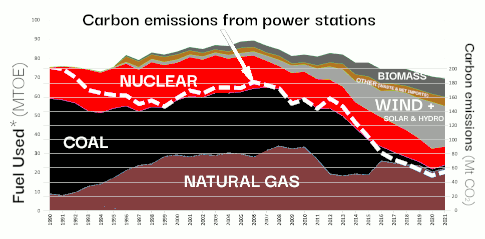Biomass: Britain's dirty secret
You’ve probably noticed the incredible growth of wind and solar power over the last 10 years, from almost nothing, to become a
serious player in our energy mix
15.8% of UK emissions (55 Mt) come from UK's POWER STATIONS ... but
UK official figures ignore an extra 20 Mt per year from Biomass which still causes climate change.
UK Electricity - Fuels Used (MTOE) & CO2 Emissions (tonnes)

Sources: DUKES 5.3, DUKES 5.1.1 and UK Emissions 2021
* For chart purposes, 'Fuel Used' for renewables is represented by the amount of coal saved, based on coal energy efficiency of 34% (from DUKES 5.6) compared to gas (45%), nuclear (35%) and biomass (25%)
75% fall in carbon emissions from power stations since 1990
25% cuts from switching from coal to gas in the early 1990s. 50% cuts since 2010 coincide with the growth of wind, solar and the burning of waste and biomass (official figures ignore the 20 million tonnes of CO2 from biomass, treating it as 'renewable').
.
But have you spotted that electricity from biomass has grown even more during that time? If it is a good thing, then why has the government been less keen to publicise the success of this supposedly sustainable technology?
Push for cleaner fuels
Rather than close down UK coal-fired power stations, some were quietly converted to burn ‘biomass’ (wood pellets) instead of coal. The once-notorious Drax power station As the UK's largest power station, Drax became the poster child for UK coal power and campaigns to end it in the 2000s. So Drax reinvented itself by converted its operations to burning wood. . claims that converting to biomass reduced its emissions by 90%. The biomass comes from waste wood, offcuts and sawdust, but also from virgin forest. The process isn’t perfect - turning wood into pellets emits a tonne of CO2 for every 4 tonnes of pellets. Then the pellets burn less efficiently than coal, making the same amount of CO2 for less energy. It’s expensive too - Drax relies heavily on government subsidies (£832 million in 2018) and tax breaks (£253 million). However, unlike coal, biomass is a renewable fuel, because at some point in the future the wood will grow back. Or at least, that’s how Drax and the government justify it. UK imports of these pellets have risen from near zero in 2010 to 8 million tonnes in 2018, mostly from the US and Canada.

